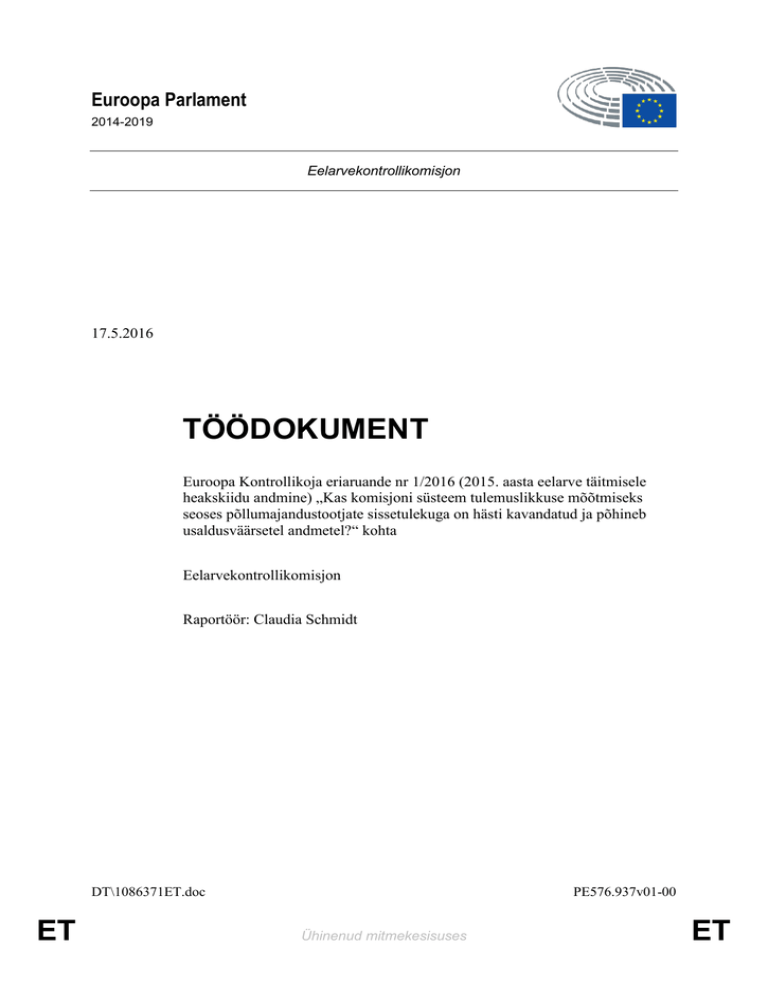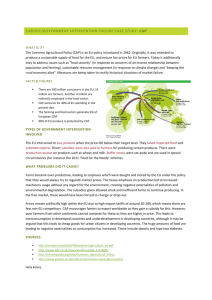ET ET TÖÖDOKUMENT
advertisement

Euroopa Parlament 2014-2019 Eelarvekontrollikomisjon 17.5.2016 TÖÖDOKUMENT Euroopa Kontrollikoja eriaruande nr 1/2016 (2015. aasta eelarve täitmisele heakskiidu andmine) „Kas komisjoni süsteem tulemuslikkuse mõõtmiseks seoses põllumajandustootjate sissetulekuga on hästi kavandatud ja põhineb usaldusväärsetel andmetel?“ kohta Eelarvekontrollikomisjon Raportöör: Claudia Schmidt DT\1086371ET.doc ET PE576.937v01-00 Ühinenud mitmekesisuses ET Audit scope, objective and approach According to article 39 of the Treaty on the Functioning of the European Union, the objectives of the Common Agricultural Policy (CAP) include increasing agricultural productivity ‘thus to ensure a fair standard of living for the agricultural community, in particular by increasing the individual earnings of persons engaged in agriculture’. The 2013 CAP reform also focused on agricultural income, in the context of the objective of viable food production, thus contributing to ensuring a fair standard of living for farmers. The Commission has to define the necessary statistical framework to measure farmers’ incomes, while Member States should provide the Commission with all the information necessary for monitoring and evaluation of the measures concerned. The Commission uses two main statistical instruments to monitor economic activities and income from agriculture and certain farm-related business activities: – the economic accounts for agriculture (EAAs), a basic tool for analysing the macroeconomic situation of a country’s agricultural sector and changes in agricultural income1; – the farm accountancy data network (FADN), a microeconomic tool whose objective is to assess incomes and business activities of commercial agricultural holdings2. The aim of the Court audit was to examine the Commission’s tools for measuring farmers’ incomes and its use of income-related data for assessing the performance of CAP measures aimed at viable food production and supporting the income of farmers. In this context the Court also reviewed the common performance indicators which the Commission recently defined for direct payments and other measures financed by the European Agricultural Guarantee Funds (EAGF) in relation to specific CAP objectives. The overall audit question was: ‘Is the Commission’s system for measuring the performance of the CAP in relation to farmers’ incomes well designed and based on sound data?’ More specifically, the audit aimed to answer the following questions. – Has the Commission clearly established what statistical data are needed for the effective performance assessment of CAP measures in support of farmers’ incomes? – Did the Commission and Member States ensure that the data used for the measurements of 1 2 The EAAs are a satellite account of the European System of Accounts (ESA 95), which provide additional information and employ concepts suited to the agricultural sector. For larger Member States, the EAAs are subdivided into regional accounts. Data collection and aggregation at national level is entirely financed by the Member States, and national statistical institutes or ministries of agriculture are responsible for data collection and the calculation of national EAAs. The Commission (Eurostat) is responsible for establishing the methodology and aggregating the data at EU level. The FADN is designed to estimate the income of commercial agricultural holdings as a business unit, whose production value, measured in standard output, exceeds a certain threshold of what is considered to cover the largest possible share of agricultural output, agricultural area and agricultural labour of those holdings run with a market orientation. It is the only harmonised source of economic data on agricultural holdings at EU level and is managed by the Commission’s DG Agriculture and Rural Development. As it is based on national accountancy data networks, the Member States finance data collection but the Commission pays a standard fee per holding for the data received from Member States. PE576.937v01-00 ET 2/6 DT\1086371ET.doc farmers’ incomes are of appropriate quality? – Did the Commission define relevant indicators allowing for the effective performance assessment of CAP measures in support of farmers’ incomes? Audit visits were carried out at the Commission and in six Member States. Together, these Member States account for more than 50 % of the gross value added of European agriculture and farmers in these Member States receive more than 50 % of the EU budget for agriculture, primarily in the form of direct payments. At the level of the Commission, the Court audited whether procedures ensured that the compilation of the EAAs and the management of the FADN were in line with the quality requirements of the framework for the development, production and dissemination of European statistics laid down in the Eurostat code of practice1. Court's findings and observations The Court concludes that the Commission’s system for measuring the performance of the CAP in relation to farmers’ incomes is not sufficiently well designed and the quality and quantity of statistical data used to analyse farmers’ incomes have significant limitations. 1. The Commission has not clearly established the statistical data needed to effectively assess the performance of CAP measures in support of farmers’ incomes a) No representative data are available on the disposable income of farm households2, which would facilitate the assessment of the achievement of the treaty objective of ensuring a fair standard of living for farmers. Also, there is no reliable system to allow comparisons to be made between agricultural incomes and those in other sectors of the economy, which could justify EU income support for farmers. b) The EAAs and the FADN provide essential data for measuring the performance of the CAP measures directed at promoting viable food production and supporting farmers’ incomes. These instruments, however, have significant limitations and important data may not be available for an effective assessment of the CAP measures aiming at the support of farmers’ incomes. The potential of the EAAs has not yet been fully used and they are not sufficiently informative about important factors that are relevant for farmers’ incomes. In particular the Commission has to date not adapted the EAAs to the new standards for national accounts and has not used the full potential of the EAAs by developing them further to provide information on the role of imports, developments in demand for agricultural products (domestic or foreign), supply to the food industry, final consumption by 1 2 In the Member States visited, the Court reviewed the procedures in place for data collection and quality assurance in respect of both the EAAs and the FADN. The purpose of the visits to Member States was also to identify good practice in terms of measurement of farmers’ incomes. Audit evidence was collected and examined against the audit criteria by means of interviews and the analysis of documents and data. In addition, the Court conducted a survey in all 28 Member States regarding the implementation of the EAAs and the FADN. Disposable income of farm households includes receipts from sales of agricultural products, subsidies, other receipts (farm-related income) and other income. DT\1086371ET.doc 3/6 PE576.937v01-00 ET households, special treatment of agriculture in the tax systems or use for non-food purposes such as production of bioenergy. Furthermore, EAA information is not always used correctly by the Commission. In particular in its annual activity reports and its annual statistical and economic information reports, the Commission uses EAA information at micro level by employing comparisons of the agricultural factor income per worker in absolute values as a key performance indicator. However, the EAAs are not expressly designed to provide data on absolute income levels or on the income levels of individual farmers. The Commission uses the indicator ’agricultural entrepreneurial income’ as a proxy for ‘family farm income and considers it to be the closest indicator for the standard of living of the farmers. However, this assumption no longer reflects the reality of agriculture in the EU, because the farming population varies significantly across Member States and no longer contains only individual (‘family’) holdings managed by sole proprietors who receive no payment for their work but also a significant share of legal entities or group holdings, which almost exclusively use paid labour. The latter are often conventional companies (e.g. investors buying large land tracts for intensive farming), as in other sectors of the economy. EAA income results can thus not clearly be attributed to ‘family farms’ and cannot be taken as a proxy for the income or standard of living of individual farmers. As the share of individual holdings across Member States also varies significantly, income results, as provided by the EAAs, are not comparable between Member States. The FADN is an important instrument for the evaluation of the CAP, but it has limitations. The income indicators do not fully take account of the evolution of holdings in the agricultural sector, while information about other farm-related incomes of farmers is incomplete. Furthermore, no income data are available at EU level for a large number of beneficiaries of EU-support1. 2. The Commission and Member States did not always ensure that the data used for measurement of farmers’ incomes were of appropriate quality; a) The Commission had insufficient up-to-date information on the EAA methodology and data sources used by Member States, reporting to Eurostat was affected by shortcomings and the quality assurance arrangements were not fully effective (see box 3 of the ECA report). This can affect the accuracy and impair the comparability of the data reported. It also calls into question the reliability of the Commission’s main indicators for monitoring the performance of the CAP. b) For the FADN, in some Member States the technical implementation of the survey affected the quality of the results, and the representativeness of the sample varied across Member States. As a consequence, not all sectors, size classes and regions were sufficiently well represented in the FADN, which reduces its usefulness for analysis purposes. Furthermore, insufficient funding by Member States for the collection of FADN data can impact the quality of the results obtained. The audit identified certain weaknesses in the quality assurance arrangements for the FADN. The Commission is aware of FADN performance problems in individual Member 1 See table Coverage of farming population and CAP beneficiaries by FADN page 27 of the ECA Report. PE576.937v01-00 ET 4/6 DT\1086371ET.doc States. However, to date no timetable has been set to improve the situation, and significant weaknesses such as inadequate coverage of sectors and size classes in all Member States, absence of incentives for the recruitment of holdings in many Member States and lack of financing still need to be tackled. The Commission is seeking to address weaknesses in the FADN and, in cooperation with Member States, is exploring ideas for a more cost-efficient data collection system. It also intends to use the FADN to provide up-to-date information on farm-level indicators for sustainability. It is, however, likely that concrete improvements will not be put into effect before the year 2017, and data will not be available before the end of 2019. This may have an impact on the evaluation of the 2013 CAP reform. 3. The Commission has not defined relevant indicators allowing for an effective performance assessment of CAP measures in supporting farmers’ incomes. Vague objectives and the absence of a baseline make it difficult to assess on the basis of the performance indicators whether individual CAP measures aiming at the support of farmers’ incomes have achieved their objectives. Member States’ choices for the implementation of direct payments are an additional challenge for the Commission’s analysis as to whether they contributed more efficiently and effectively to achieving the CAP objectives and thus added EU value. The Commission’s indicators in relation to viable food production and farmers’ incomes are not sufficiently reliable or are not linked clearly enough to CAP measures to show that they contributed effectively and efficiently towards the desired effects. Limitations in the availability of data further reduce the relevance of the indicators. They are also not informative as to whether the objectives were efficiently achieved, which requires an indepth analysis of the factors impacting farmers’ incomes. Töödokumendi koostaja soovitused võimalikuks lisamiseks iga-aastasesse eelarve täitmisele heakskiidu andmist käsitlevasse raportisse Euroopa Parlament soovitab et: 1. Komisjon töötab välja põhjalikuma statistilise raamistiku, et anda teavet põllumajanduslike majapidamiste netosissetuleku kohta ja paremini kajastada põllumajandustootjate elatustaset. Sellel eesmärgil peaks komisjon – koostöös liikmesriikidega ja võttes aluseks ühise metoodika – kaaluma, kuidas oleks parim viis arendada ja kombineerida olemasolevaid ELi statistilisi vahendeid. 2. Komisjon parandab raamistikku põllumajandustootjate sissetuleku võrdlemiseks muude majandussektorite sissetulekutega. 3. Komisjon arendab põllumajanduse arvepidamist edasi, et paremini ära kasutada selle potentsiaali järgmisteks eesmärkideks: – põllumajandustulu mõjutavate tegurite kohta üksikasjalikuma teabe andmine; – piirkondliku tasandi andmete ülekandmise tagamine liikmesriikidega kokkulepitud ametliku korra kohaselt. DT\1086371ET.doc 5/6 PE576.937v01-00 ET 4. Komisjon uurib, kas põllumajanduse arvepidamist saab edasi arendada, et teha mõistlikke hinnanguid põllumajandustootjate loodavate avalike hüvede majandusliku väärtuse kohta, ja tagab, et põllumajanduse arvepidamise teavet kasutatakse sissetulekunäitajate puhul nõuetekohaselt. 5. Komisjonipoolne põllumajandustootjate sissetuleku analüüs põhineb põllumajanduse praegust olukorda arvesse võtvatel näitajatel ning piisavatel ja järjepidevatel andmetel kõigi ÜPP meetmete toetusesaajate kohta. Seda saaks teha, arendades olemasolevate haldusandmete omavahelist koostoimet, või arendades FADNi või muid sobivaid statistilisi vahendeid; 6. Arvestades põllumajanduse arvepidamise tähtsust ÜPP seires, kehtestab komisjon korrapärase põllumajanduse arvepidamise kvaliteediaruandluse ja saab piisava tõestuse, et liikmesriigid võtavad kasutusele kvaliteeditagamise raamistiku, tagamaks liikmesriikide esitatud andmete võrreldavuse ja kooskõla Euroopa statistika suhtes kohaldatavate kvaliteedikriteeriumidega. 7. Komisjon tegeleb FADNi rakendamisel avastatud puudustega, leppides asjaomaste liikmesriikidega kokku selge ajakava ja ergutades süsteemi potentsiaali paremini ära kasutama. 8. Komisjon arendab edasi liikmesriikide FADNi statistika koostamise kvaliteedi tagamise praegust korda, et kõigis liikmesriikides oleksid ÜPP kohaldamisalasse kuuluvad sektorid ja ettevõtete suurusklassid piisavalt esindatud, kajastades ka liikmesriikide ÜPP võimaluste hulgast tehtud valikuid. 9. Arvestades kontrollikoja tuvastatud puudusi, suurendab komisjon põllumajandustootjate sissetulekut täiendavate ÜPP meetmete tulemuslikkust käsitleva teabe usaldusväärsust ja terviklikkust järgmiste meetmetega: – asjakohaste tegevuseesmärkide ja algväärtuste määratlemine juba algfaasis, millest lähtuvalt saab järgmise programmitöö perioodi jaoks võrrelda ÜPP meetmete tulemuslikkust; – oma hindamiste kontekstis tulemusnäitajate praeguse raamistiku täiendamine muude asjakohaste ja kvaliteetsete andmetega, et mõõta saavutatud tulemusi; – samuti oma hindamiste raames põllumajandustootjate sissetuleku täiendamiseks mõeldud meetmete tõhususe ja mõjususe hindamine. PE576.937v01-00 ET 6/6 DT\1086371ET.doc



